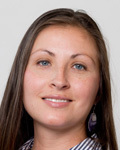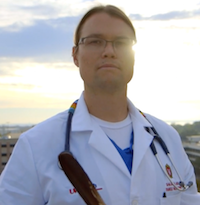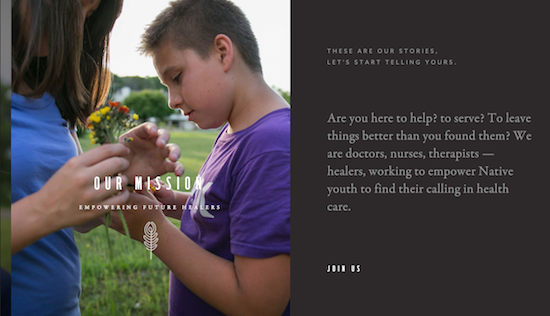Creating pathways: connecting American Indian students to health professions
We are Healers is an initiative to encourage more American Indian students to pursue careers in health care.
In the past three years, the number of applications from American Indian students to the School of Medicine and Public Health has exploded, increasing by 250 percent. This increase coincides with the creation of the UW-Native American Center for Health Professions (NACHP), a relatively new program established to connect American Indian students to careers in health care.

Melissa Metoxen
Melissa Metoxen, community and academic support coordinator and member of the Oneida Nation of Wisconsin, believes that this connection is critically needed.
“American Indian people are the least represented group in health professions out of all the underrepresented groups in Wisconsin,” she says. “Most of our tribal communities in Wisconsin fall within health professional shortage areas [HPSA].” The 2014 Indian Health Service report also shows American Indian people experience disproportionately substandard health conditions than the rest of the general U.S. population.
In the last several years, NACHP and the School of Nursing have been working to address these disparities. Together these groups are collaborating to break down barriers that deter American Indian students from pursuing careers in health fields with the larger vision of improving the health and wellness of American Indian communities in Wisconsin.
“Our goal is to transform UW–Madison into the gateway for Native American entrance to health professions,” says Metoxen, who joined NACHP shortly after it was created to help expand outreach to prospective students and serve as an advisor to currently enrolled students.

Erik Brodt
One of the major initiatives led by Metoxen was strengthening partnerships with Wisconsin tribal communities. Through this effort, NACHP has collaborated with several tribes to create opportunities for students to complete their clinical experience, internships and rotations at Indian Health Service Clinics located on reservations in Wisconsin. Just this fall, a fourth-year medical student completed her six-week preceptorship at the Oneida Community Health Center.
According to Erik Brodt, an assistant professor of family medicine who is founder and former director of NACHP, Metoxen has played a central role in the department’s growth. “She fuels students’ success by providing excellent guidance, encouragement and mentorship,” he says. “We have seen an unprecedented increase in Native American health professional students, and she is the reason.”
Metoxen has also expanded outreach to prospective students in tribal communities. One of her most successful strategies has been to utilize NACHP’s digital mentoring website, called We Are Healers. The website showcases short, engaging videos of American Indian people working in health professions and provides a behind-the-scenes look at their jobs. These stories help American Indian students explore health fields and connect to mentorship tools and resources.
Although NACHP’s efforts have proven successful, Audrey Tluczek, an associate professor of nursing, says there is still one significant gap in the health professions recruited: nursing. The five-year IHS INMED grant that funds part of NACHP’s efforts expressly excludes this profession due to separate funding available for nursing through other federal organizations.
“Nurses represent the largest workforce not only in tribal clinics, but nationwide, so it’s a logical starting place if you want to improve the cultural sensitivity of health care,” says Tluczek, adding that even the reservation health clinics are staffed by a non-Native majority. “Nurses tend to have the most interaction with patients, and only 0.4 percent of Wisconsin nurses identify as being American Indian or Alaska Natives.”
Tluczek first became involved when the Great Lakes Inter-Tribal Council (GLITC) began a survey of nursing practices in Indian country. The results were troubling. According to the project’s report, there was evidence of cultural biases, lack of understanding about American Indian culture and lack of knowledge about the health disparities among American Indian people in Wisconsin.
GLITC reached out to Tluczek, who was then the chair of the Equity and Diversity Committee for the School of Nursing, to work on a Wisconsin Partnership grant to address these issues. “Ineffective communication, biases and misunderstanding can have unintended consequences, such as misdiagnoses or inadequate treatment,” Tluczek says. She also points out that if a patient is dissatisfied with the relationship with their health care provider, it could lead to an avoidance of seeking care.
“We want to see more American Indian leaders and role models. Diversity is the path to excellence in education and would ultimately improve the quality of our teaching.”
Audrey Tluczek
GLITC was awarded the grant, “Increasing Cultural Congruence among Nurses in Wisconsin,” and initiated a series of “talking circles” at four Indian Health Service Clinics and one in Milwaukee.
“Traditional talking circles have been used by indigenous cultures of North America as a way of addressing important issues, educating and problem solving,” says Tluczek. Based on the results gathered from pre- and post-evaluations, the series was a great success. Participating nurses reported a significant improvement in their understanding of American Indian culture, recognition of discrimination and racial bias and a greater appreciation for the value of incorporating traditional American Indian culture into their work.
The grant also allowed GLITC and the School of Nursing, along with NACHP, to host the Native Nations Nursing Summit this last November, where over 100 nurses, college and high school students, university advisors, tribal educators, counselors and community members came together to discuss issues and brainstorm solutions surrounding American Indian access to nursing careers.
Tluczek is also awaiting news of a recently submitted grant proposal for a program named STREAM, Success Through Retention, Engagement and Mentoring for American Indian Students Pursuing Nursing Careers. STREAM would allow the School of Nursing to collaborate with Metoxen and NACHP to create a pathway from American Indian communities to the profession of nursing.
Mel Freitag, director of diversity initiatives in the School of Nursing, co-wrote the grant with Tluczek and emphasizes that the feeling of belonging is key to academic success. The grant would provide a structured cohort or a supportive community of peers for American Indian students to rely on. The cohorts would work closely together and meet during monthly talking circles facilitated by Metoxen and NACHP. Freitag also plans to continue efforts to ensure American Indian students are engaged with UW–Madison advisors and NACHP faculty who can connect them to resources and opportunities and assess bigger picture academic and career goals as they plan for graduation.
Tluczek hopes that the program will eventually lead to more American Indian graduate students, faculty and staff on campus. “We want to see more American Indian leaders and role models,” says Tluczek. “Diversity is the path to excellence in education and would ultimately improve the quality of our teaching.”
To learn more, visit wearehealers.org.
—Jaime Kenowski




